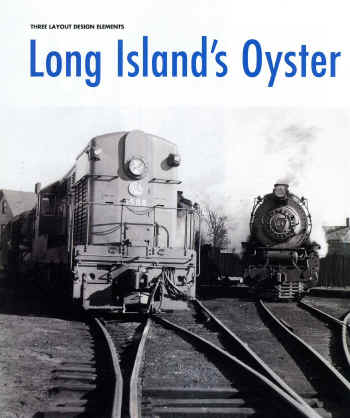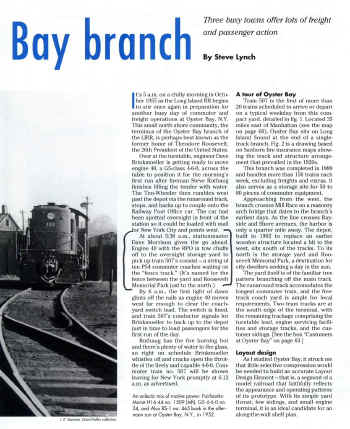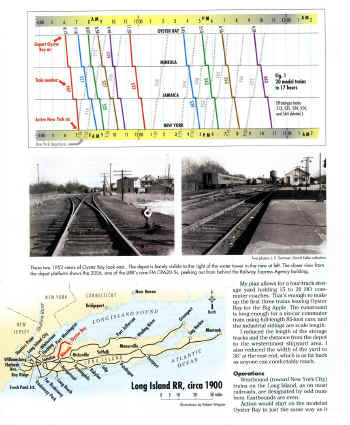|
Modeling the Prototype
1966:
Located 35 miles east of New York City, the single track Oyster bay
branch terminates on
the shore of the Long Island Sound in the town of Oyster Bay. Handling
approximately 120-160 trains per week, excluding extras and freights, it
also serves as the daily storage point for 75-80 pieces of commuter
equipment.
The basic yard design is that of a tree pattern leading from the single
track main. Commuter car storage
(freight also) is handled on the 3 north tracks. The two holding tracks
are the extreme south tracks, with the remaining trackage being the turntable lead, engine storage tracks, and
the customer sidings.
Here's what we have to work with from the LIRR:
Long Island Coal Co. Coal/heating oil supplier - 5 car capacity
Jakobson Shipyards - 3 car capacity
Oyster bay Lumber - 5 car capacity
Water barge Oil Terminal (unknown capacity)
Roosevelt Memorial Park visitors
Here are the incoming/outgoing modeling operations:
Establish a loading facility for outbound oil tank cars. (2 car
capacity)
Incoming parts in boxcars and engine crates/etc. on flat cars for the
shipyard (2 car capacity)
Incoming coal hoppers to Long Island Coal Co. (2 car capacity)
Incoming lumber loads and boxcar paint/parts/supplies (2 car capacity)
Outbound boats on flatcar load (Excuse to use the Athearn car)
Commuters/visitors to/from Oyster Bay
Here are the operational problems:
1. The shipyard lead is right off the main interfering with passenger
operations
2. The lead into the Coal Tipples is the arrival/departure track for
commuter trains.
Here are the compromises:
1. Selective compression of industries
2. Saving space and cost by eliminating extra storage sidings
3. Balance realistic switching with the commuter train in/out
operation.

The HO scale selectively compressed version designed into a 3' by 20'
area.
|
|
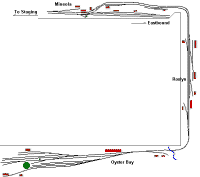
Oyster Bay Branch LDE
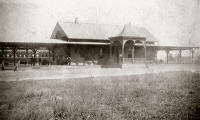
Station c.1898

03/31/36 Photo: Votava
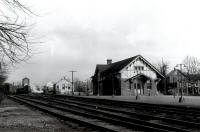
02/29/48 Photo: E. Hermanns

8/01/10 Photo: Al Castelli
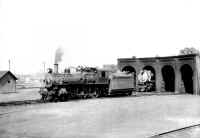
Engine House-D56s - G5s #21 1926
Collection: Dave Keller
|
1958 OB Branch Sidings Latham Bros. Lumber, prior to
1926, was located south (west) of Lincoln Avenue and a siding was
installed in 1924. It remained in use for Latham Bros. until the company
moved to the location you're familiar with in August, 1926.
The newer location of Latham Bros. had several additional spurs
branching off the original 1926 one. One was added in 1947 to access
Charles F. Hubbs and another added in 1954. These were all still in use
in 1959 when my maps were drawn.
It appears that most of the major freight activity on the Oyster Bay
branch ended by 1959.
Here are additional industrial sidings and team tracks serviced by the
LIRR around that time:
East Williston:
Reserve Supply Co. (Former Latham Bros. siding)
Nassau Farmers Corp. Supply (out of service: 1954)
National Biscuit Co.
Mineola Coal Co.
East Williston Coal (out of service: 1948)
East Williston team track
Albertson:
Berlin Steel Co. (just north [east] of the old Motor
Parkway overpass)
Albertson team track (out of service: 1954)
LILCO (south [west] of Long Island Expressway underpass) (out of
service: 1956)
Levitt (builder) sidings north (east) of the LIE underpass
Roslyn:
Nassau Grain
Roslyn team track
Helena Rubinstein cosmetics (south [west] of Rt. 25A underpass) (new:
1953)
When I was a teenager I used to tag along with the conductor on the Oyster Bay freight, which ran every Monday, Wednesday and Friday.
Their first stop was a lumber yard south of Mineola Coal where I met up with
them as there was a lay over track. Mineola Coal was on one side of Jericho Turnpike and on the other side was a large switching area they called "the Hole". In that large complex was Mineola Paper, Albertson Lumber, Local Steel,Minoela Plumbing, Latham Brothers Lumber, Winsdor Coal, Pittsburgh Glass, an Iron Works Company, a candy company and another paper company at the end. After spotting cars there we always took a yellow fruit growers express refrigeration car and put it behind the engine, this was done just about every time on the scheduled run. The fruit growers express refrigeration car was headed to Helena Rubenstein . We would lay over either at the Hole or Mineola Coal and wait for the next north bound train to Oyster Bay as soon as the block would clear we would follow it up to Roslyn. At Roslyn we would leave the main body of the train in Roslyn and take the car up to Helena Rubenstein. I remember the conductor telling the engineer to go extremely slow on that siding, something about the curve not being right. After we spotted the car and picked up our empty we head back to Roslyn. By this time the southbound train going to Penn Station would have gone by and we would get permission to cross over at the Roslyn Crossover and leave our empty cars and any cars for Roslyn on the south side and any cars we had for Albertson's Steel we had which was on the south side. We would cross back over pick up our loaded cars and head north towards Oyster Bay. Our next stop was usually Sea Cliff. There was a team track in Glen Head , but it was rarely used,if it was gondolas with boulders in them.
Thanks to: wbill500
Glen Head:
Patterson Fuel
Glen Head team track (out of service: 1959)
Sea Cliff:
Sea Cliff Coal and Lumber (out of service: 1959)
Sea Cliff team tracks (out of service: 1959)
Glen Cove, Glen St.:
Nigro Coal and Lumber
Titus & Bowne Coal
Glen St. team track (out of service: 1959)
Locust Valley:
Nassau-Suffolk Lumber
Locust Valley team track
Mill Neck:
Mill Neck team track (out of service: 1951)
Oyster Bay:
Jakobson Shipyard (siding still 1983-85) Info: Dave Keller
L. I. Coal Co.
Oyster Bay Lumber Co.
Oyster Bay team track (out of service: 1959)
|
